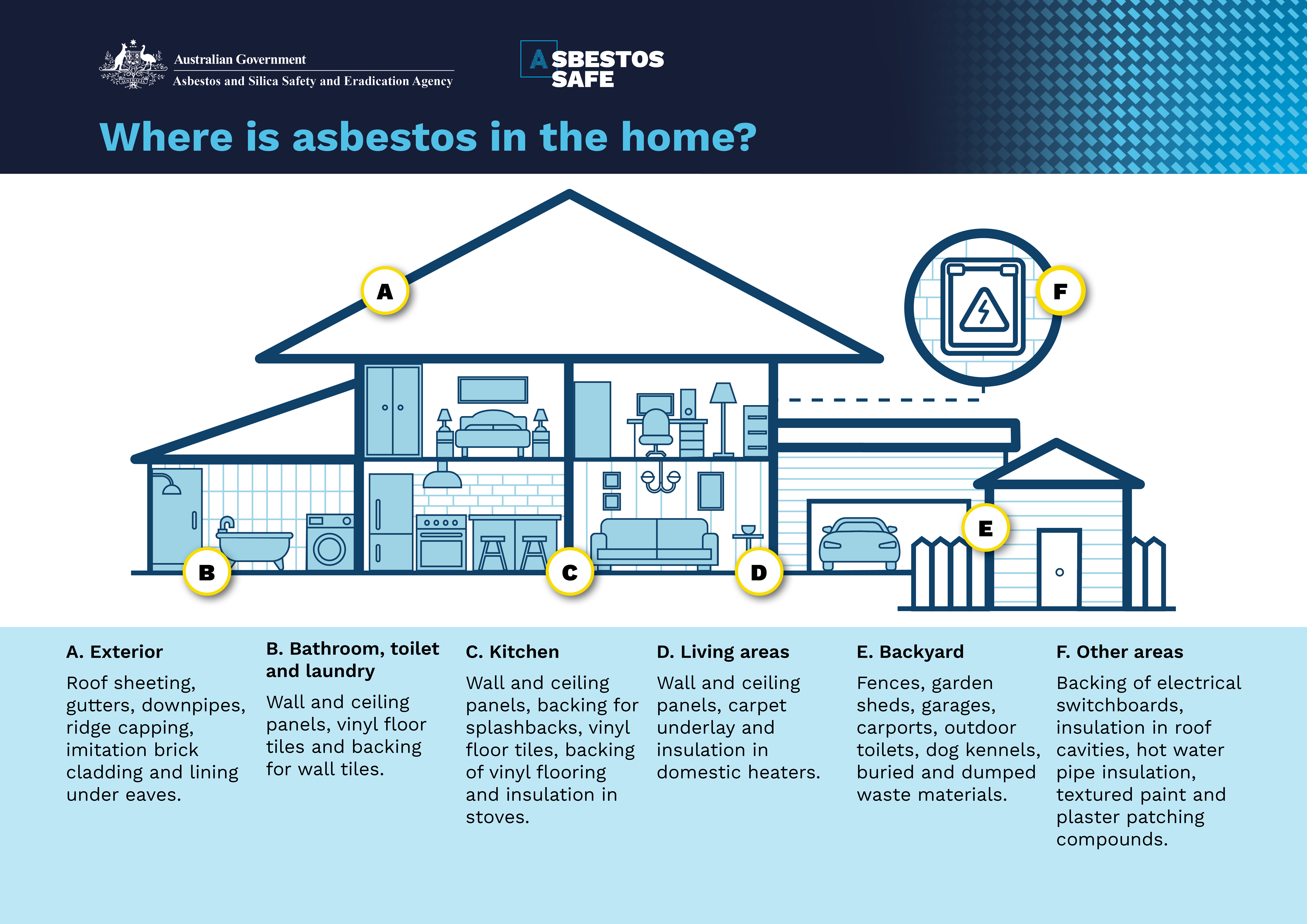Knowing if your home contains asbestos is important for the purposes of protecting your health and that of your family, particularly if you are planning any home improvements, repairs or renovations or at the point of buying, selling or renting a home.
Where is asbestos found?
If a home was built before 1990, it can contain asbestos both inside and outside:

The Asbestos Product Guide has more information on the wide range of asbestos materials that were used in Australia and where they can be found.
How to check for asbestos
It is usually difficult to tell if something contains asbestos just by looking at it. The only way to confirm this is by having a small sample of the material tested in an accredited laboratory.
An asbestos professional can conduct an asbestos assessment (also known as an asbestos survey or asbestos inspection) to identify whether asbestos materials are present in your home, their location and condition, and provide you with guidance on how to manage the risks.
Follow these steps to be safe:
- Know where asbestos could be in your home before you start doing any repairs, home improvements or renovations. If in doubt, have the material tested, or assume it is asbestos.
- Take precautions to prevent disturbing asbestos materials and releasing asbestos fibres into the air.
- Safely remove asbestos if it is damaged or in poor condition.
- Engage a licensed asbestos removalist when undertaking major home renovations where asbestos might be present.
For more information see Practical guidance for householders and home renovators
What rules apply to asbestos in the home?
Everyone has a duty under common law and public health laws to take reasonable care not to cause harm to another person. This includes preventing the release of airborne asbestos fibres in and around your home.
There are activities that you must never do when working with or removing asbestos-containing materials:
- Do not use power tools, such as angle grinders, circular saws and electric sanders to cut, drill, grind or sand asbestos materials.
- Do not use high pressure water or compressed air to clean asbestos materials.
- Do not use brooms to dry-sweep asbestos containing dust and do not use household vacuum cleaners even if they have a HEPA filter – hire a specialised class H vacuum cleaner with a HEPA filter instead.
- Do not place any asbestos materials or asbestos contaminated items in household rubbish bins – all asbestos waste must be wrapped and disposed of at a licensed asbestos waste facility. Search for disposal facilities.
Any tradesperson, handyman or contractor that you hire to carry out repairs, maintenance or other work on your home (e.g. painting, plumbing or electrical work) must comply with work health and safety laws. This means they must follow strict safety procedures and may not be able to remove asbestos unless they have a license to do so. They may ask you for information about the presence and location of asbestos in your home.
Environment protection laws have requirements relating to the management and remediation of contaminated sites as well as the transport, storage and disposal of asbestos waste.
Check your insurance
Insurance policies may have exclusions for asbestos, or the level of coverage under a policy may not be enough to cover your actual expenses if asbestos materials are accidentally damaged or disturbed, e.g. during renovations, in a house fire or storms. You can lower your risk of accidental damage and uninsured costs if you check for the presence of asbestos and, if possible, plan to have it safely removed.
For more information see Asbestos liabilities and insurance
Disclosure of asbestos when selling or renting residential properties
Providing information about the presence and location of asbestos when a property changes hands or new residents move in helps keep everyone safe from potential exposure.
Pre-purchase building inspection reports generally do not cover asbestos and therefore a specific asbestos assessment may be needed.
The presence of asbestos in a residential property doesn’t need to be a deal breaker. Residential properties containing asbestos are bought, sold, leased and rented every day in Australia. By knowing where asbestos is, new owners can plan for its safe removal.
Watch our videos for information about the importance of disclosing the presence of asbestos in a residential property when it is being sold or rented, and the rights and responsibilities of buyers, sellers, renters and landlords.
Read our fact sheets on the asbestos disclosure requirements that apply in each state or territory.
Our Asbestos in residential property disclosure tool includes a diagram that shows the common places where asbestos might be in a home and some warnings about when asbestos is dangerous.





